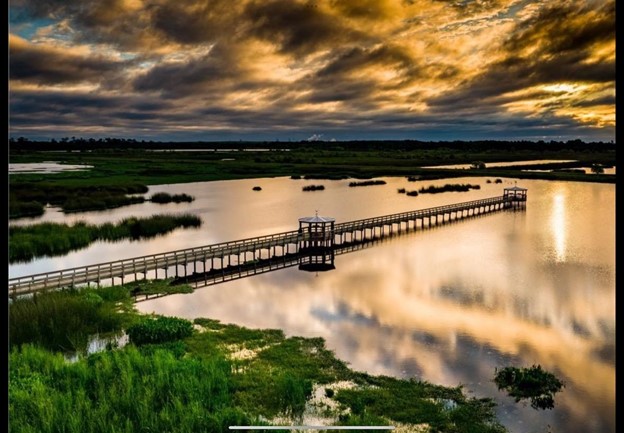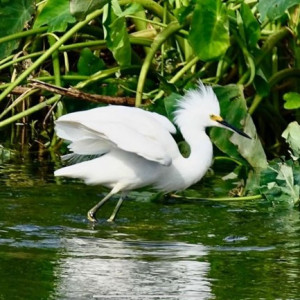Cattail Marsh and the Wetlands Education Center at Tyrell Park
A gentle fog lifts from the still waters as Cattail Marsh awakens with life. The soft and soaring silhouettes of brown pelican’s dance in the sky while the sun peeks over the horizon. A white egret poses majestically for a nearby photographer, and all the while, a symphony of sounds fills the air while insects, birds, even the occasional alligator come to life in the morning light.
It’s a typical morning at Cattail Marsh, located in Southeast Texas on the outskirts of the city of Beaumont, Texas. Comprised of nearly one thousand acres of marshland and surrounded by twelve miles of gravel levee trails, Cattail Marsh offers a variety of recreational and educational activities for both traveling tourists and locals.
Cattail Marsh is classified as a “wetlands ecosystem.” Wetlands are among the most biologically diverse ecosystems in the world, and Cattail Marsh is no exception. Home to a myriad of plants, birds, wildlife, and other species, Cattail Marsh embodies this biological diversity beautifully. Because of its location at the convergence of two major migratory flyways, in the winter months, Cattail Marsh serves as a rich habitat for many species of birds and waterfowl. Diversity of fauna and flora abounds, and other wildlife, including rabbits, turtles, amphibians, reptiles, and fish, have found the marsh to be a satisfying habitat. Posing no threat to the reasonably prudent hiker, even alligators can be seen sunning serenely along the banks of this unique ecosystem.
Prior to 1993, the region of Cattail Marsh was originally used as a wetlands for rice farming. According to the farmers, the existence of the ecosystem seemed to improve the water quality for downstream fish and wildlife. Scientists later confirmed their discovery: In the marsh, microbes along the plant roots purified the waters downstream by filtering out contaminants and toxins. In this way, Cattail Marsh served – and still serves – as a natural wastewater treatment system. As a result of this discovery, efforts were made by the Beaumont Public Utilities Department to conserve this unique wetlands, and upon its completion in 1993, Cattail Marsh was the largest constructed wetlands in the country. Today, Cattail Marsh continues to provide hope for future innovative environmental solutions where expansion of society and conservation work can exist hand-in-hand.
In 2016, the construction of a new boardwalk with viewing platforms was completed at Cattail Marsh. Extending nearly one hundred meters over the marsh, the boardwalk provided new access and incredible views to visitors, scientists, and birders from around the country.
In 2018, the Magnolia Garden Club of Beaumont completed the building of the Wetlands Educational Center overlooking Cattail Marsh. Offering stunning, 360-degree views of the marsh, the Educational Center is two-stories high with a wrap-around porch and large, receding windows. The Wetlands Educational Center provides outreach and education to visitors, families, and students. Various workshops and classes help to educate and inspire an understanding of and an appreciation for nature. Magnolia Garden Club, one of the finalists for the 2018 GCA Founders Fund and received $10,000 was used in the construction of this building.
The Magnolia Garden Club recently added the development of a community “pocket park,” approximately 75 yards deep and 50 yards wide. With the inclusion of five different types of vegetation, this particular pocket park is designed to attract migrating woodland birds as well as resident species. Located near the Wetlands Educational Center, the avian pocket park includes native shrubs, forbs, grasses, ground cover, and large trees.
The Marsh is forever changing. In its own, unique way, Cattail Marsh teaches the people – and visitors – of Southeast Texas about the beauty of nature, the importance of coastal conservation, and strategies for innovative environmental solutions. Visitors from around the world, including renowned photographers, birders, ecologists, and scientists, have discovered the unique beauty and biodiversity of Cattail Marsh, conveniently located just one mile from Interstate-10.






